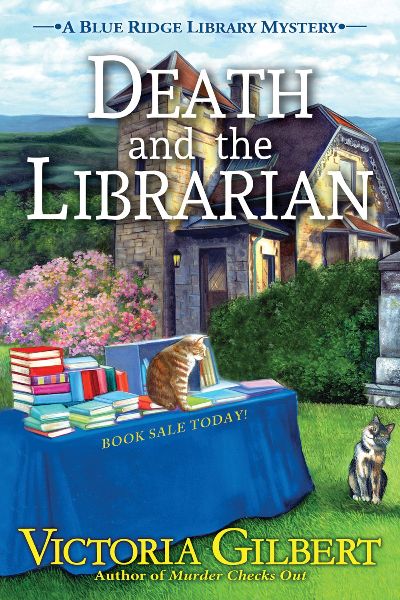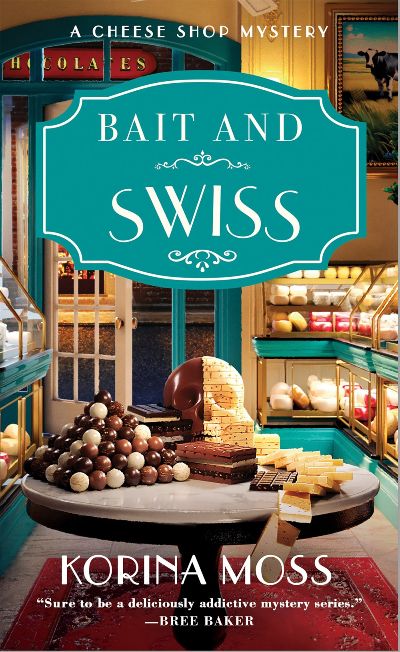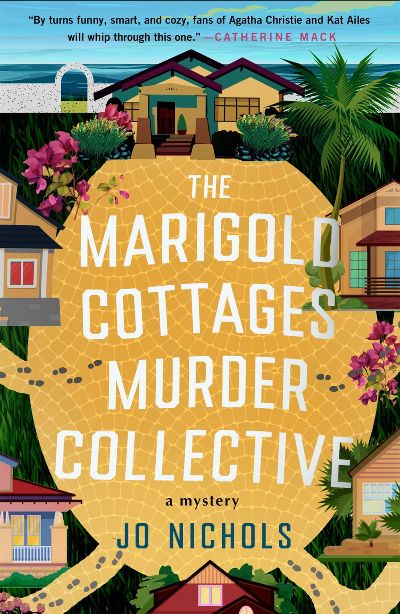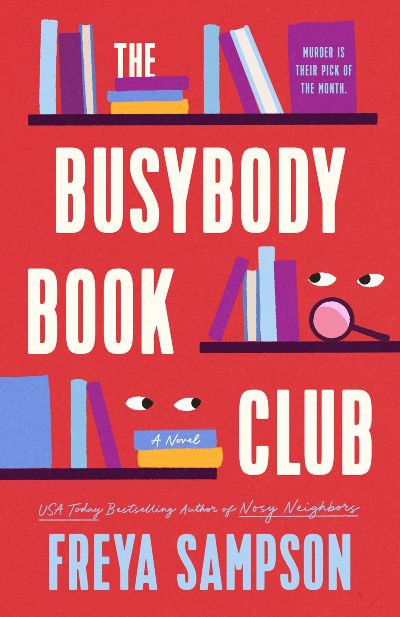A case from almost 60 years ago threatens the present in Gilbert’s (Schooled in Murder, 2025) latest addition to her terrific Blue Ridge Library mystery series. A true-crime author, Maureen Dryden, visits the library run by Amy Muir to give a book talk and pursue a cold case from the area for her next book. She’s famous for writing about an unsolved crime in her previous book, and her identification of the killer resulted in the accused dying by suicide. One of the folks Maureen’s trying to track down is Kurt Kendrick, godfather to Amy’s children. When Maureen dies, Kurt ends up at the top of the suspect list. Amy’s investigation goes badly from the start, and Kurt is a bit too angry and demanding when Amy asks him questions, scaring her. It seems that bringing up the past makes a lot of residents in town reluctant to provide answers. When Amy starts receiving death threats, she realizes she might have gone too far this time. Gilbert does a terrific job of keeping the pace while showcasing a realistic small town with relatable characters. The solution to the mystery might seem obvious, but Gilbert has a few twists in store that will keep the reader guessing until the last page.
Amateur Sleuth
Cozy mysteries have a template of sorts. They are usually set in a small town, and often set in a small business with a friendly, plucky, sleuthy heroine. Trouble, sometimes from the past, drops into the mix to spoil the perfection. Bait and Swiss is a fine example of the genre, with all the proper elements in place from chapter one. Willa and her incredibly simpatico team from her cheese shop, Curds & Whey, preparing for their second anniversary celebration, pause to attend the grand opening of a neighboring cake shop. Surprisingly, the cake shop includes a chocolatier run by Willa’s ex-fiancé and best friend from 10 years ago. In the chaos of the opening, Willa delivers samples of the chocolates to the newspaper editor, a reporter is poisoned, and the lovely town is in a panic. Willa’s relationship with the hunky local detective is in danger, but she sleuths on, partnering in a somewhat slapstick style with the editor. Food sales are down all over the town as the population fears poison from all quarters, but friendships hold firm and instincts are strong though the who-done-it is a surprise. The recipes at the end underscore the power of cheese. Fun all around from Moss (Cheddar Off Dead, 2022).
Arranging an exhibit “Inspired by Shudder Pulp dime magazines and the legend of our very own lake monster” promises to be a fun project for artist Charley Scott, curator of her small-town Canada art gallery. Local lore about the Nessie-like monster should be enough to draw the curious, but it makes one local, Laura Bouchard, very upset. Laura shows up at the gallery angry and dishevelled, with two things she’s adamant about. First, she was just attacked by the lake monster. Second, Charley had better not go ahead with this exhibit. When Laura is later found dead of “dry drowning,” or dying of water inhalation hours after the fact, Charley sets to work getting to the bottom of the myth and what really happened to Laura. Cozy fans will enjoy the small-town tale that’s complete with eccentric locals, a chocolate shop that offers a worrying subplot, and Charley’s steadfast dog. Darker elements are added: Laura was not well liked in the town, for example, and elements of witchcraft creep in, making this a tale both for cozy fans and for those who like a more sinister mystery. This is the second in the series, and readers will want to go back to the first installment, Cover Art.
Attention anglophiles, lovers of dazzling historical fiction, and fans of a good draught of droll humor. This book is for you. Set in the Inner Temple, the heart of legal London for centuries, with its own degree of independence (not unlike the Vatican), the novel features Gabriel Ward KC, a brilliant legal mind who moves each day at the same measured pace between his chambers, which are crammed with books on nearly all topics; his office; and the dining hall. But on May 21, 1901, he emerges from his room only to discover a body on his doorstep. In fact, Ward is quick to identify it as the corpse of the Lord Chief Justice, who now has a Temple carving knife in his chest. But what is even more shocking isn’t that he is clad in evening wear, but that his feet are bare. How delicious is this plot? Appointed by the Temple’s Treasurer to investigate the murderer, Ward is paired with the eager and charming young Constable Wright, whose street knowledge turns out to be quite an asset, gaining Ward’s respect. The investigation drags the pair from the upper classes to the homeless, with an entirely separate court case—in children’s publishing, no less—providing some entertainment of its own. Quite simply, this is one of the very best debuts I’ve read in a long time; it’s sure to delight the Osman and Thorogood crews and readers of Sarah Caldwell’s legal murder mysteries as well.
With its seven eccentric residents, charming historic bungalows, and a beautiful Santa Barbara setting just minutes from the beach, this novel will remind readers of Armistead Maupin’s Tales of a City series, although the latter lacks a mystery element. But they do both share an aging, somewhat hippy matriarch who owns and governs her own complex, and Mrs. B., the landlady of the Santa Barbara Marigold Cottages, only rents to those who need a leg up. Mrs. B.’s latest acquisition is Anthony, a reserved hulk with a prison background and the tats to prove it. Anthony makes the other tenants anxious, and when a dead body is found on the grounds of the cottages, the tenants, with the exception of Mrs. B, all point to Anthony. But Mrs. B. remains certain of his innocence, and heads down to the police station to turn herself in. Wonderfully eccentric with deep dives into many of the characters’ lives, this quickly paced read provides the perfect summer mystery.
Yes, the comparison to Only Murders in the Building is inevitable (as it is to The Marigold Cottages Murder Collective, above, not to mention The Thursday Murder Club). All are narratives of place, in which the residents of a building, or buildings, are deeply involved in the story as amateur detectives, suspects, or both. Marchfield Square inhabits the smallest block of squares in London, with many of the units—Rear Window-like—facing internally, providing residents with a great deal of information about one another, but with little opportunity for actual conversation, at least without hollering across the courtyard. Remarkably, the elderly heiress who owns the complex, Celeste van Duren, is not just still alive, but actively engaged in running it. So when one of the residents is murdered (he totally deserved it), Celeste appoints two of the tenants—Audrey, a young woman who works as Celeste’s cleaner, and Lewis, a somewhat failed novelist—to a team responsible for investigating the murder. Because as we all know, the real police can’t be trusted to do anything right. Audrey and Lewis have to work out their own difficulties, but eventually the two are seen together snooping about the Square tracking the activities of their neighbors and friends. And guess what? Everyone has something to hide. This is loaded with humor and packed with punch, and cozy readers will be sure to keep a look out for more from this Audrey/Lewis duo.
Nova Davies has relocated from London to a remote Cornish seaside town, in part to be with her fiancé, whom she is set to marry in a little more than a week. While Nova loves her job as a social worker in the local community center, she can’t help but be a bit frustrated by her clients. Must the five members of her book group—a real bunch of misfits if there ever was one—argue about everything? But that’s just the beginning of a series of misfortunes, all of which seem to point to Nova. First one of their own, a book group participant, disappears, only to have a dead body show up in his house. Then a significant sum of money, earmarked to repair the community center’s ancient roof, goes missing—could Nova really have been so dizzy that she forgot to lock up the building? There’s a lot of fun to be had here, from Phyllis, an Agatha Christie superfan who insists on using Christie’s plots to solve the murder and find the funds, to Nora, whose life couldn’t become more complicated thanks to a full-on control freak of a mother-in-law and a mom who’s stranded in South America, likely to miss her wedding. And the fiancé? Please dump him. A delight from start to finish, and sure to please cozy readers who appreciate strong characters, a great community setting, and a dollop of criminal activity. For readers who enjoy Lucy Gilmore and Emily Henry.
Readers of this author’s Tess Monaghan series might remember Muriel Blossom as a minor character. She’s plump and elderly, which gives her the ability to disappear into the background, making her effective at surveillance. But life is very different now. For one thing, a found lottery ticket has made her wealthy. She is on her way to France to meet an old friend for a cruise on the Seine, and arrives so early for her flight that she is upgraded to business class. Allan, gray-haired, attractive, also early, takes her under his wing, giving her a melatonin gummy to help her sleep. When they arrive in London too late for her connecting flight to Paris, he shepherds her through the unexpected day. This is not what our Muriel is used to, and though she is flattered and intrigued, her natural skepticism and self-awareness are ever-present. In Paris, she is confronted with murder, art theft, and an FBI agent (or is he?) and a newer, stronger, more outspoken version of herself. The river cruise offers more interests, but also more dangers, and ultimate solutions. Overarching all are Muriel’s memories of her dead husband and a lifetime of shame for her weight, which she finally confronts. The story is complicated, but the character of Muriel is so compelling and wonderful that it’s more important than any crime. Here’s a woman who has found her rhythm and style along with the culprits. Readers cannot fail to love her.
Might this book be a cozy mystery? Let’s run it through my cozy-meter and find out. One, do we have much empathy for the lead character? Absolutely. Daphne Brewster, a Black woman—in fact, the only person of color as far as the eye can see—has moved her husband and family out of south London to a Norfolk town called Pudding Corner to escape urban woes. She’s become so successful at selling antiques that she’s now known as the vintage lady. Still, it turns out that things are as complex in Pudding as they are in London. Two, isn’t the book too slow? No. If you want faster, go find James Patterson. The characters in this town are so absolutely delightful as they roam about the town that I would happily spend another day or two with them. Again, the name: Pudding Corner. Might that be a hint as to what we can expect? Three, is it sexy and violent? Much more yearning than sexy. And if there had been any sex, it was years ago. As to the violence, it is offstage, involving a corpse that keels over in his allotment patch—a little garden the size of a postage stamp where Brits go and plant rutabaga on the weekends. Four, is this book a stand-alone? We hope that the publisher is sensible and Ms. Sutton will be back to delight us again with Daphne and Book Two.
An utterly heartfelt, entertaining, and beguiling sophomore effort from Dukess, author of The Last Book Party (2019). Cath is finally going through the possessions of her recently deceased mother. Cath was raised by her grandmother, and her relationship with her hippy mom consisted of intermittent and impulsive visits throughout her Buffalo childhood, with mom disappearing nearly as fast as she would arrive. So it’s a shock when Cath finds among her mother’s possessions the tickets for “murder week,” in which a quaint British town is staging a fake murder to bolster tourism, with all the locals taking on a role. But even more remarkable is that Cath’s mother—who as far as Cath knows never left the U.S.—planned for them to go together. What was she thinking? Nevertheless, Cath can’t quite shake the idea of murder week, and in several weeks time, she finds herself in England’s Peak District, sharing a cottage with Wyatt, who back in the States works in his husband’s birding store, and Amity, a divorced romance novelist who is suffering from writer’s block. Dukess deftly handles multiple narratives: the search for clues to the hamlet’s fake murder; the unearthing of shocking revelations about Cath’s family; and a slow-moving, present-day romance. A joy for Anglophiles and chock-a-block full of humor, this coziest of cozies will delight fans of Vera Wong, Finlay Donovan, and The Thursday Murder Club.










